|
|
Post by EdoBosnar on Jan 9, 2017 16:16:13 GMT -5
Now that's what I'm talking about! Some interesting stuff here. I had that first issue of Ms. Mystic - snapped it right up back in the day because I was so stoked to have a comic drawn by Adams, and a first issue to boot. Then I read it and was a bit underwhelmed. And then it took almost a year for that second issue to come out, by which point I had lost interest anyway.
I remember seeing the house ad for Edge of Chaos in another Pacific comic, but I never had it; sounds interesting, though, as does Silverheels, something I only heard about once the internet appeared (same goes for another obscure series that apparently started at Pacific: Sun Runners).
As I mentioned in an earlier post, I currently have Darklon, which I enjoyed despite it's rather dark tone. Very Starlin indeed. I also have one of those First Elric collections, which I'm really looking forward to reading. Wouldn't mind having the Rog 2000 book, even though I have most of the stories in it, as I have the original issues of E-man in which they appeared.
Really enjoying these posts...
|
|
|
|
Post by codystarbuck on Jan 10, 2017 0:26:02 GMT -5
      Somerset Holmes This is, by far, my favorite series produced by Pacific. Oh, I love Starslayer and Mike Grell; but, it didn't have the kind of gripping suspense that this has, or the intriguing characters, or the anything can happen plotting. It was Grell playing in the same sandbox, in a different park (good as it is). The Rocketeer was barely a series, so I don't really count it, in that Dave Stevens barely scratched the surface and didn't really have a complete story until the Eclipse Graphic Novel version. We'll get to that, in time. No, this is tops; and, yet, I didn't read it until about 10 years ago. I had seen the graphic novel in my local shop, while I was in the Navy; but, never picked it up. I remember house ads in Eclipse comics; but, never picked it up. Then, a decade ago, I was visiting my parents, who happened to be living in the city where I was stationed (they had moved there when they retired, when I was first commissioned and I ended up assigned to a ship there). While visiting, I went to that old local shop, The Green Dragon, which always had a great selection of graphic novels and discovered they had a box full of ones from Eclipse, First, Catalan, and a few others, that nobody wanted and they just let people read them for a buck. I pulled out a stack of Torpedo albums (to complete my set), and they let me have them for the same buck each. I then decided I would get more, and started pulling out everything that had caught my eye in the past or did so now. Anyway... Somerset Holmes is the work of Bruce Jones, his wife April Campbell, and artist Brent Anderson. Campbell and Jones first met when he was trying to do a photo novel, with an eye towards breaking into Hollywood. Campbell was a model, who was writing a spec script. They met and hit it off and a romance blossomed (which led to two divorces, as both were already married). They headed west and ended up in San Diego, where they ended up working with Pacific, doing Alien Worlds and Twisted Tales. They wanted to work with Brent Anderson (who had worked with Jones on Ka-Zar, at Marvel). It was a brilliant idea and they conceived a suspense/mystery/noir tale, of an amnesiac woman, a mysterious key and lots of people trying to find and or kill the woman. What sets it apart? Well, look at those covers, for a start. They look like the kind of covers you would get for a pulp mystery novel, from a writer like Mickey Spillane and an artist like Robert McGinnins. That was something new in comics. Thing is, the covers are just the start, though they convey the mood and tone of this series. If Alfred Hitchcock had done comics, they would have been something like Somerset Holmes. The series begins with a woman walking by the side of the road, when she is hit by a car and injured. 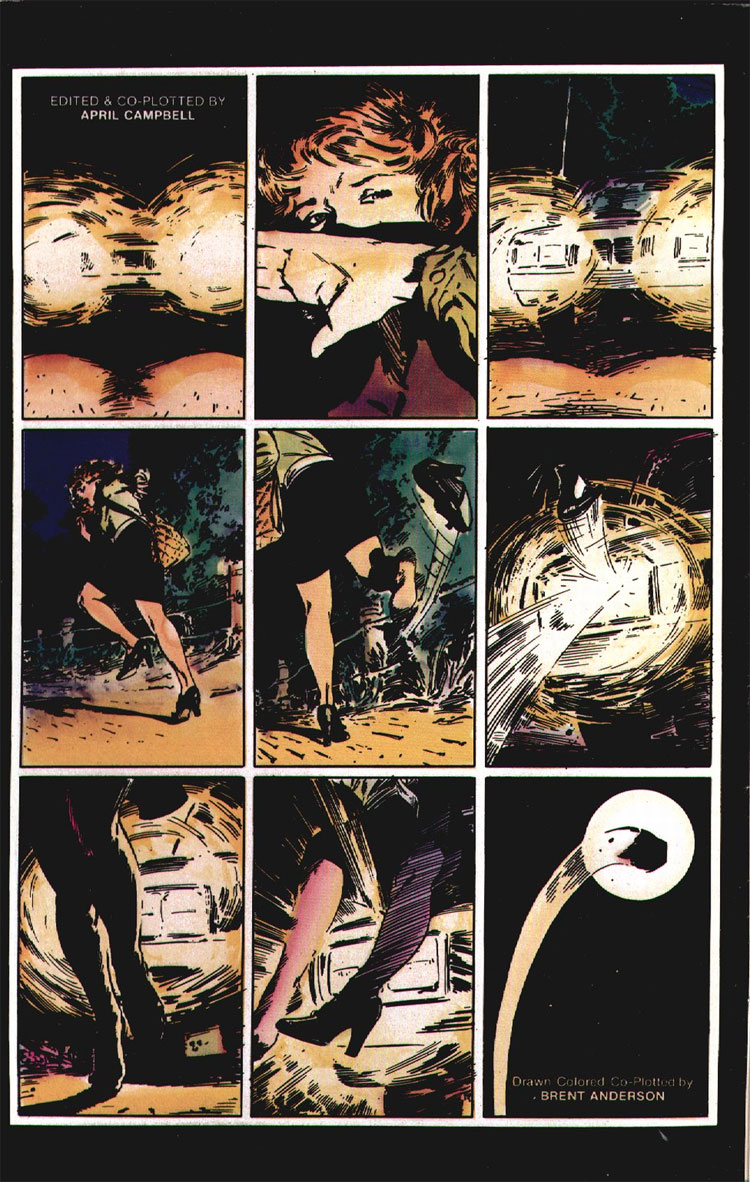 She is injured; but, alive. She makes her way to a nearby town and finds a doctor, who will treat her injuries, and has her fill out paperwork. Except, she can't remember her name, address, or any other part of her past. 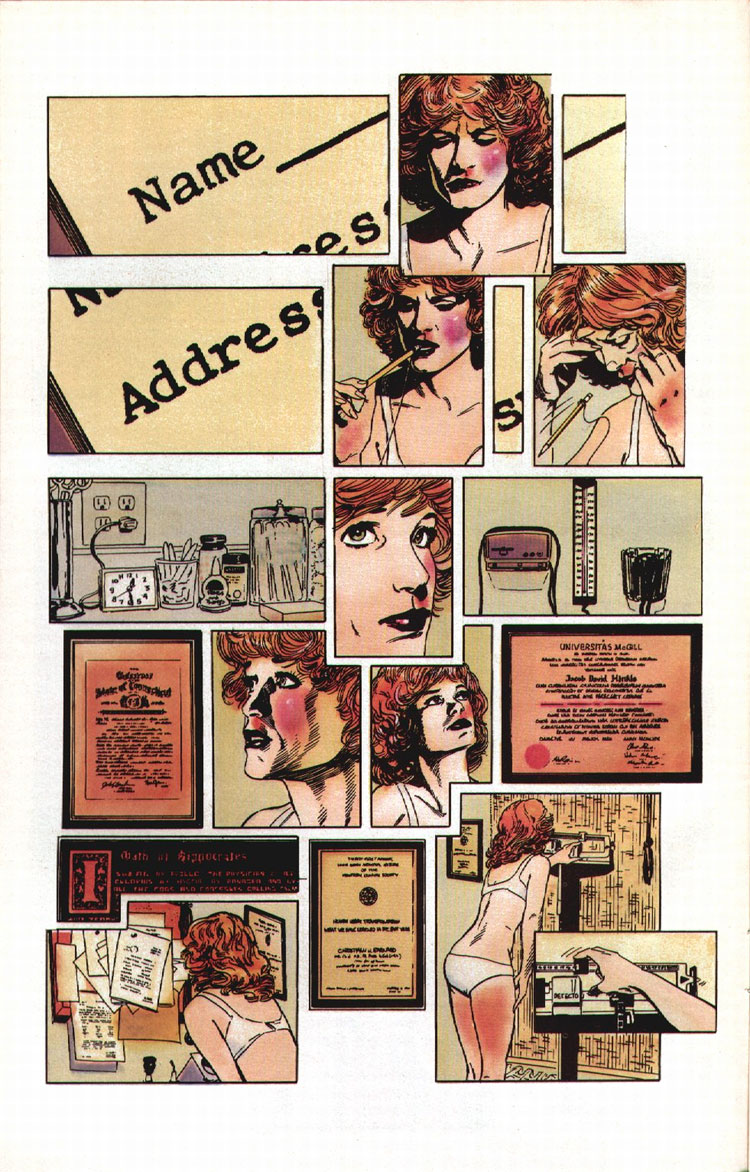 She soon finds the doctor dead and hightails it out of there. This begins a journey to New York and Los Angeles, where she will encounter people who will help her and try to kill her. Many aren't who they appear. There are secrets galore. All she knows is that she has a mysterious key that was hidden in her belt and a sewn in label in her clothes. This leads her to a sex shop, a train ride, and a showdown on the rooftops of two buildings. The plot is terrific and sucks you in. The heroine, Somerset, is fantastic. The mystery of her identity gets more and more involved, as she demonstrates a high level of physical skill, as she fights off attackers and pursuers, while escaping through windows, jumping ledges and riding the tops of trains. She was something special, in her past. If this sounds a little familiar it is probably due to a Robert Ludlum thriller that was adapted into movies, twice: The Bourne Identity. There are similarities. however, the Jones/Campbell/Anderson take on things is more rooted in Hitchcock's North By Northwest ans similar films. Brent Anderson's art is moody and arresting and he used photographs of Campbell for the heroine of the story. The name, as we see in the story, comes from a billboard for a housing development, when a stranger asks her name. it will take until the climax for us to learn her true name and why she was on the side of that road, when she was hit, and why she cam leap onto trains and fight off truckers and killers. Pacific published 4 issues, before going under. Eclipse Comics picked up many of their series, including this one, and finished it; then, they collected it into a graphic album.  At the time of the album, in 1987, the series had been optioned for a movie, by Ed Pressman, producer on Conan the Barbarian and, later, The Crow. Pressman optioned several comics for potential films, in the 80s and early 90s, and the few that made it to the screen were pretty good. Unfortunately, this was one of the ones that never saw the light of day. However, it got the Joneses work in Hollywood, for a time. Now, if that wasn't enough, the book also features a back-up tales, also from Jones: Cliff Hanger, and ode to the Saturday matinee serials. It features a woman in search of her father, a famous entomologist, who went missing in the South American jungles. She comes in contact with our hero, Cliff, a soldier of fortune (read: gun runner) and adventurer and pilot. Together, they run into a series of mishaps and, well, cliffhangers, as they discover a diamond mine and a secret Nazi operation to build a trans-Atlantic tunnel, for nefarious purposes. Sounds pretty cool, right? Would be a nice companion to the Rocketeer. Want to know what makes it even cooler? Hunh? (GET ON WITH IT!!!!!!!) Al Williamson. Yep, EC stalwart, illustrator of Flash Gordon and the Star Wars newspaper strip, Secret Agent Corrigan (with Archie Goodwin) and all around terrific adventure artist. Check this out... 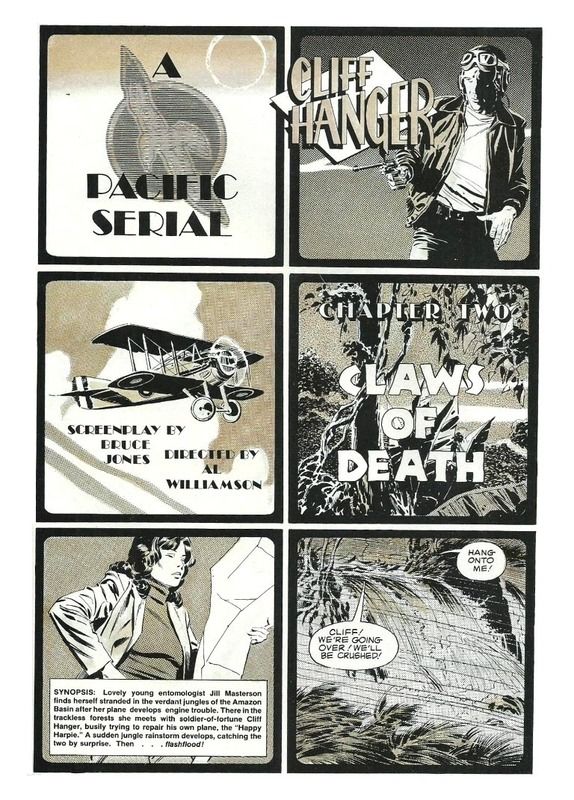 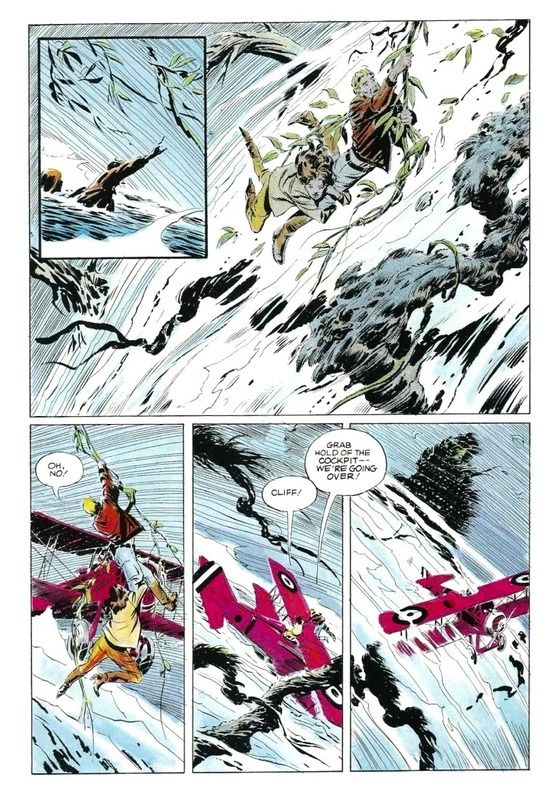  All it needs is Tom Tyler or Kane Richmond! This is Indiana Jones-type stuff, from the same inspiration, the movie serials of the 30s and 40s. It's beautiful and lots of fun, as Cliff is the wise-cracking type. The only thing that could make this cooler is a crossover with the Rocketeer or Crash Ryan (both inspired by serials). This is one area where Pacific seemed to excel, pulp adventure, and an area that Eclipse picked up and ran with. If you like Indiana Jones, Republic serials, Terry & the Pirates (or Scorchy Smith), Jonny Quest, Jimgrim, Doc Savage, or any other of the great adventure stories of the 20th Century, you will love this. Now, how badly will all of this set you back? Would you believe less than the cost of the average trade paperback? That's right; since the mainstream doesn't know from characters who don't wear their underwear over their pants, you can get the 6 issues of Somerset Holmes for about $2 each ($6, for issue 1). The graphic novel can be had, in paperback, for between $15 and 30, depending on condition and source. There is also a hardcover edition, which is a little pricier; but not astronomical. Oh, and April Campbell? 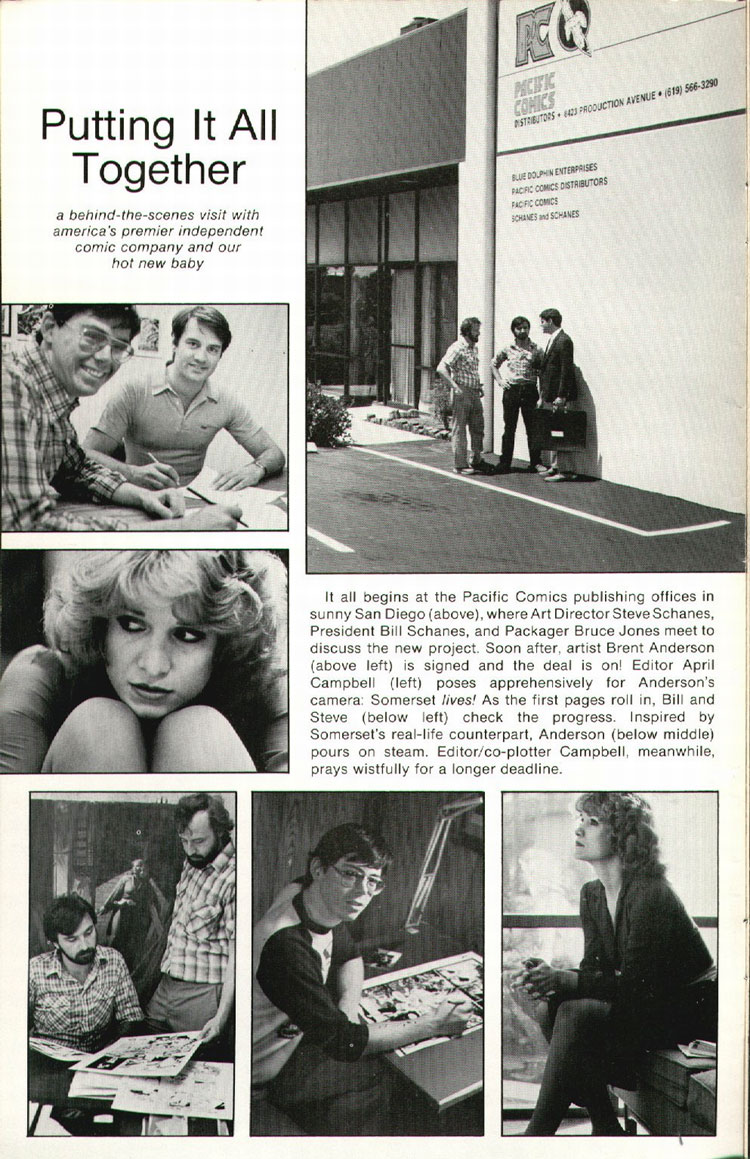 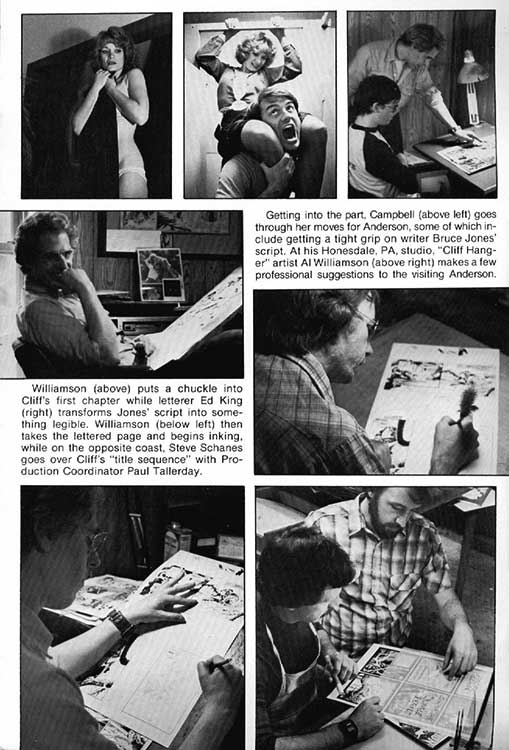 Turns out, she's a pretty darn good writer, herself. |
|
|
|
Post by mikelmidnight on Jan 10, 2017 13:12:34 GMT -5
Somerset Holmes actually kind of traumatised me.  Specifically because I didn't like it. It just seemed bland. Which made me question whether all my claims about wanting to see more realism in comics was nothing more than intellectual pretension. Fortunately, other comics came out later with a more realistic bent which I did in fact engage with. |
|
|
|
Post by EdoBosnar on Jan 10, 2017 13:24:28 GMT -5
Yeah, Somerset Holmes was another one that I only heard about much, much later. And I really wouldn't mind having it.
By the way, your summary of the plot makes me immediately think of that (rather solid) 1990s thriller "The Long Kiss Goodnight," starring Geena Davis. Apparently Jones and Campbell thought so, too, as they've made statements to the effect that the movie basically plagiarized their story (although I'm not sure they ever took legal action).
|
|
|
|
Post by codystarbuck on Jan 11, 2017 3:14:52 GMT -5
Yeah, Somerset Holmes was another one that I only heard about much, much later. And I really wouldn't mind having it. By the way, your summary of the plot makes me immediately think of that (rather solid) 1990s thriller "The Long Kiss Goodnight," starring Geena Davis. Apparently Jones and Campbell thought so, too, as they've made statements to the effect that the movie basically plagiarized their story (although I'm not sure they ever took legal action). If they consulted a lawyer, they might have pointed to Ludlum and their Hitchcock inspirations and advised against it, as it would be hard to prove and a long and costly affair. But, yeah, there were more than a few similarities. Looking back, it's both sad and amazing how long it took for my tastes to mature enough to move past superheroes into stuff like this. I read enough of it in prose fiction; but, wasn't seeking it out in comic books. I always read comics other than superheroes; but, it took me a while to start sampling the wares of some of the independent publishers, apart from superhero titles. I glanced at Airboy on the stands for a while, before I picked it up, in earnest. I loved that thing, once I started reading it. i was way late to Scout, having just picked up the handbook, after the original run ended. I started with Swords of Texas and then started hunting for all of the issues, starting with the trade collection of "The Four Monsters." I had already been reading Jon Sable and American Flagg and Lone Wolf & Cub. It took even longer to try DNAgents and Crossfire and I only recently hunted down Lost Planet, Luger, Merchants of Death and some of Eclipse's other pulp adventure titles. I guess it took getting burnt out on the bulk of the superhero titles to begin really looking for alternatives. Working in a bookstore helped speed up the process. |
|
|
|
Post by codystarbuck on Jan 12, 2017 23:18:39 GMT -5
  Wait, what is this? We already did Starslayer! Yeah; but, we aren't focusing on Starslayer this time. This time, we are going to talk about...   THE ROCKETEER!!!!!!!!!!!!!!!!!!!!!!!!!!!!!!! I know, last time, I said Somerset Holmes is my favorite series from Pacific; and, it is. However, The Rocketeer is on a whole 'nother plane of love. Ever since I was a kid, I have loved pulpy, pseudo-futuristic adventure. I devoured Jonny Quest, on Saturday mornings. I thrilled to the Bell Jetpack in Thunderball (and Gilligan's Island). I loved the cool gadgets of the future in the Jetsons. So, you take an adventure hero and strap a rocket pack to his back and I'm in! It also helps that my father was a lifelong aviation enthusiast and it rubbed off on my siblings and I. he took us to the Osh Kosh Air Show, back in the early 70s and the Wright-Patterson Airforce Base Museum, when we were older, as well as Cape Kennedy. So, you add a Gebee 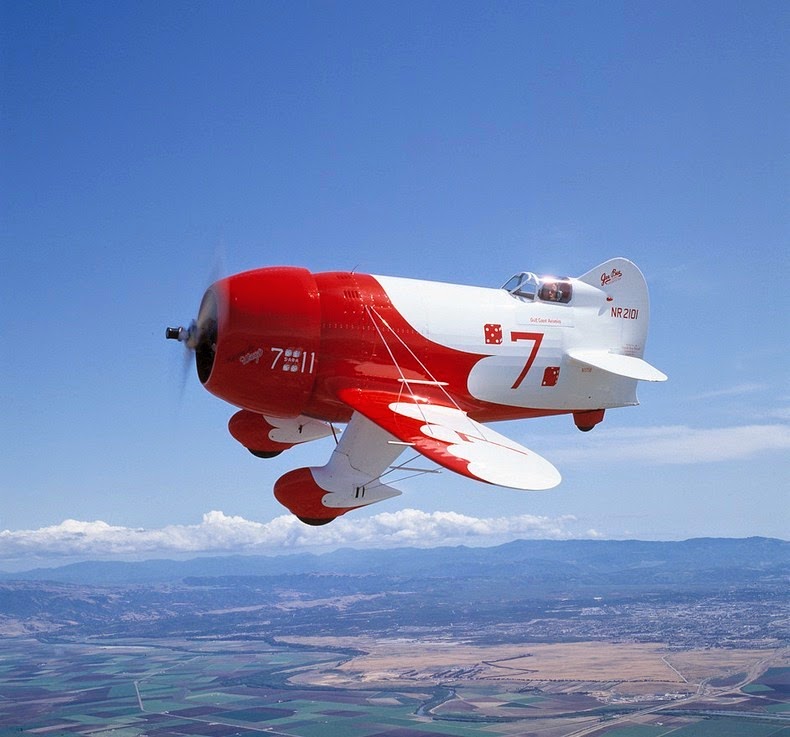 and some other planes, and I am in even more. And, if you polish it off with Bettie Page? I'm in heaven! Dave Stevens was known in and around fan circles and had produced some artwork here and there and even a few stories. He did an art assist on at least one issue of the original Marvel Star Wars adaptation. He worked for several of the animation houses and also did movie storyboards. At Pacific, he combined several loves of his into a series that has transcended its humble origins. Stevens loved the period of the late 30s; the music, the air races, the movies, the pin-ups, the design and more. All of that is filtered into The Rocketeer The series started humbly, as a back-up in Starslayer. Issue 1 features an ad for the upcoming story, on the back of the book.  Issue 2 introduces us to Cliff Secord, a pilot in an air circus who is looking to earn some dough to keep his girl happy. Fate intervenes when a car chase smashes through the airfield gates and some crooks mess around with Cliff's plane. After the police catch the crooks and cart them off, Cliff checks out his plane and finds the world's craziest looking vacuum; except, it's a rocket. He has figured out how he can earn that dough. Fate gets involved again as he is forced to make an unscheduled debut, to rescue a friend from danger.. 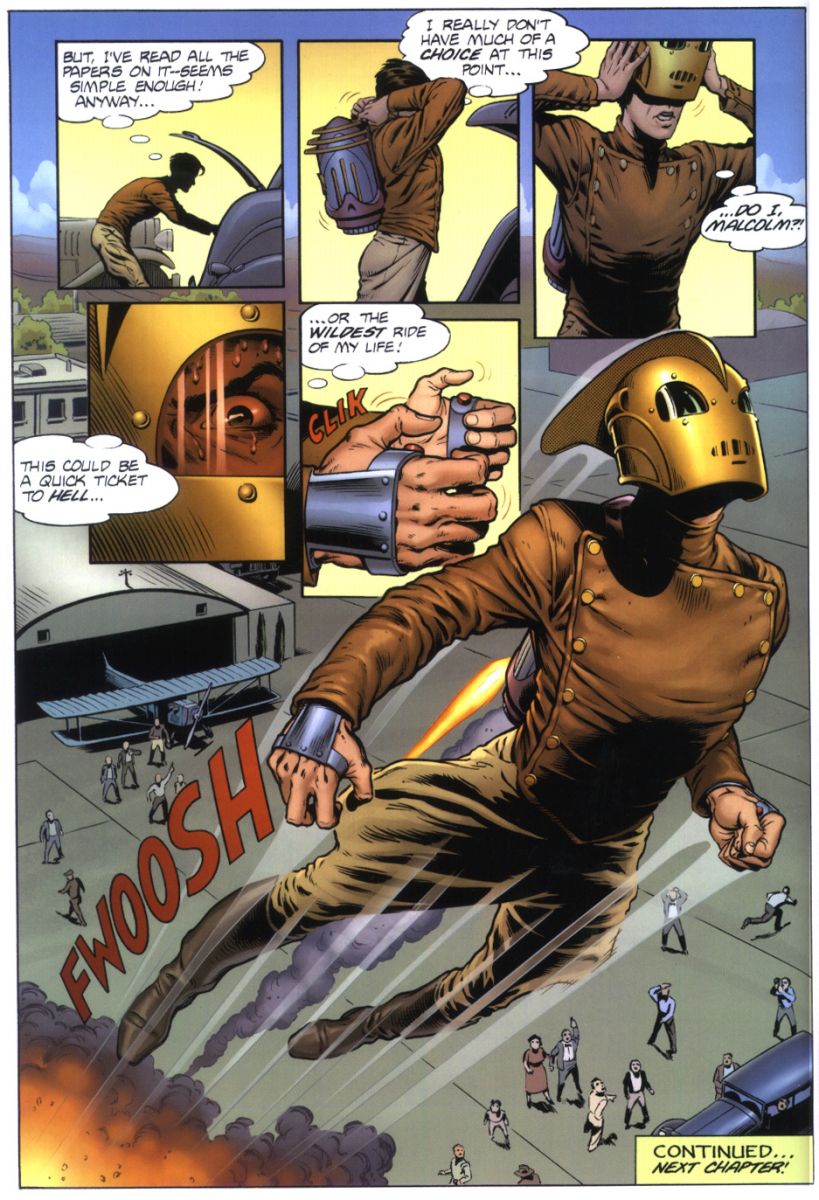 Paced like a movie serial, the story picks up in the next issue and we also get introduced to Cliff's girl...  The story picks up in Pacific's new anthology series, Pacific Presents...   Now, Dave wasn't exactly fast and the amount of detail he put in these things is amazing; so, you had to be patient. he also had a day job, which paid the bills, allowing him to do this kind of thing. So, there was a gap after issue 2 of PP. Dave had the next installment ready to go, when Pacific went belly up. It ended up published at Eclipse...  That gave a finale to the storyline, one that included the inventor of the rocket pack, one Clark Savage Jr (MD, PhD). We also got to see two of his associates, Lt. Col. Andrew Blodgett Mayfair and Brig. Gen. Theodore Marley Brooks. You might know them better as Doc Savage, Monk and Ham...  Now, how about dem apples? Doc Savage creates a rocket pack, it's stolen by Nazi spies, ends up in the hands of a stunt aviator, who uses it to rescue his friends and his girl and who aids Doc in stopping other Nazi's from stealing an advanced plane! Man, that would be one awesome serial. Eclipse gathered the whole thing together, got Harlan Ellison to write a forward and gave us the Rocketeer Graphic Album...  Is that a thing of beauty or what? Eclipse also gave us the bonus of extra pages, as Dave inserted a scene where Cliff runs after Betty, after she storms out, seeing him all banged up after his first outing; and, one where the bound and gagged Betty fights her abductors, in the back of a car, as Cliff tries to catch up to it, with the rocket. My memory is hazy; but, there may have been at least one more added story page (I only have the IDW edition, now). After that, The Rocketeer moved to Comico, for two issues, where Cliff headed off to New York and got involved with Kent Allard (aka Lamont Cranston aka The Shadow) and his associates, and some former friends and enemies.    Dave had speed problems and Comico had money problems; so, Dark Horse finished the series and collected it.  Meanwhile, Hollywood came calling and a movie was filmed and released.  The film was excellent, truly capturing the spirit of the comics and it stayed mostly faithful to the main plot. To avoid legal issues, Betty's name was changed to Jenny and Doc Savage was replaced by Howard Hughes. It still worked. Add to that, Timothy Dalton as a pseudo-Errol Flynn, a Rondo Hatton homage, and Paul Sorvino as the mobster hired to steal the rocket pack and you have an awesome film. On top of that, they set the climax on a zeppelin!!!!! The Rocketeer is pure adventure and is such breezy fun that you can forgive its shortcomings. The plot is thin and it has a lot of coincidences; but, it was inspired by a movie serial... The story is wrapped up a bit too neatly and the characters aren't that fleshed out, with little in the way of backstory. However, you can ignore all of that and enjoy the thrills, the humor, and the sex appeal. You have to wonder, though; would it have been as successful without Betty? I like to think it would; but, I doubt it would have been more than a cult hit indie comic had Dave not included Miss Page and not had a way with depicting the female form. That got it attention beyond comics and probably did more to attract Hollywood than anything. Plus, the character adds so much to the story, beyond the damsel-in-distress role. Cliff and Betty are a mature couple and they have a great romantic relationship; though one with a lot of selfish behavior. Betty wasn't the only homage, as mechanic Peevy was based on friend and Jonny Quest creator Doug Wildey, while the slimy photographer Marco, was inspired by glamour photographer Ken Marcus (and a bit of fetish artist/photographer Eric Stanton). The Bulldog Cafe was based on an actual LA eatery, back in the 30s and the New York Adventure is filled with homages to movie stars and films, like Tod Browning's Freaks. The Rocketeer went on to become a beloved classic and spawn the Rocketeer Adventures, with others taking their turn with our hero and his girl. Betty even gets to suit up, which has spawned dozens of cosplay re-enactments, though I haven't come across one, where Betty is a bit more sensibly, though still sexily attired. Betty in riding breeches and boots is just as sexy as garter belt, stockings and heels, in my book. If someone has done it, the photographers seemed to have ignored it. The Rocketeer wasn't the only thing that Dave Stevens did for Pacific. He did some work with Bruce Jones, on Alien Worlds and also some art and story in Vanguard Illustrated. We'll look at those next, along with the other Bruce Jones collaborators and Pacific contributors. For now, though, I leave you with Bettie/Betty... 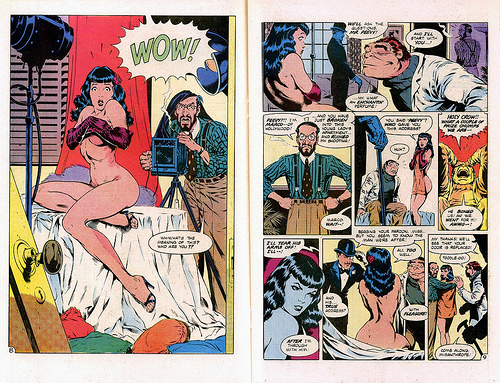 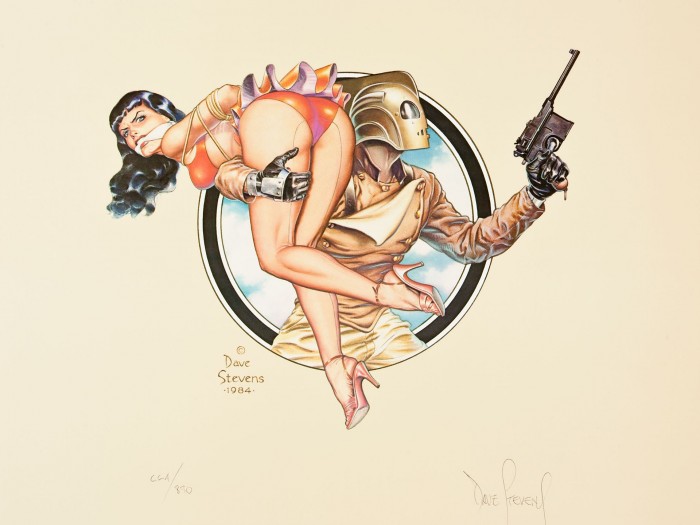   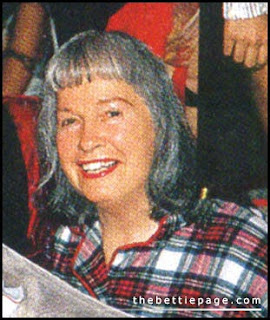 Bettie Mae Page, 4/23/1923-12/11/2008 and Dave Stevens  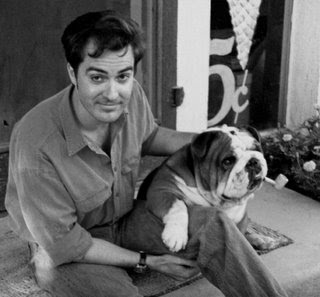   Dave Lee Stevens, 07/29/1955-03/11/2008 |
|
|
|
Post by Deleted on Jan 12, 2017 23:37:26 GMT -5
I have many of the early Rocketeer appearances, but I stumbled upon that Eclipse volume in a used book store a little over a year ago and finally got a chance to sit down and read all of the original saga last year. Great fun. The Rocketeer Adventures stuff from IDW is very good as well, plus some of the cross-overs IDW did such as the Rocketeer/Spirit book. A great source for more Rocketeer adventures is a prose short story antholgy IDW did a couple years back called Jet Pack Adventures...  it was a fun bunch of stories. -M PS I think it was thanks to that anthology that I finally figured out what the technical name was for the style of trousers he wore that were ubiquitous in a lot of 30s-40s era stuff I saw all the time... jodhpurs |
|
|
|
Post by berkley on Jan 14, 2017 0:30:52 GMT -5
Somerset Holmes actually kind of traumatised me.  Specifically because I didn't like it. It just seemed bland. Which made me question whether all my claims about wanting to see more realism in comics was nothing more than intellectual pretension. Fortunately, other comics came out later with a more realistic bent which I did in fact engage with. There's something about it that doesn't quite work for me either, though I find it hard to put my finger on exactly what it is. I think it might have something to do with working from photographs or posed models: maybe it's a technique that works for portraits or stand-alone illustrations but not for sequential story-telling, for some reason, though I don't immediately see why it shouldn't. Perhaps even the most realistic style needs some subtle exaggeration or emphasis of certain elements to convey a sense of life and movement, at least in a comic as opposed to an illustration. Whatever it is, the overall effect on me is that it lacks some dynamism or energy in some way. Compare it to the equally realistic but somehow more exciting Al Williamson story sampled above, for example. Of course it isn't really fair to compare anyone to a master like Williamson, who is going to outshine almost any other artist you can name. |
|
|
|
Post by codystarbuck on Jan 15, 2017 15:35:06 GMT -5
More Pacific...         Bruce Jones was his own little cottage industry, at Pacific. He had a deal that basically gave him full control to create and package comics for them, resulting in Alien Worlds and Twisted Tales (as well as Somerset Holmes). These are basically the kind of stories you could find in Eerie and Creepy, at Warren (where Jones cut his teeth), as well as homages to EC (which is what Warren, essentially, was). I haven't read all of the material; but, most are typical tales of the Warren style, with the twist ending. What sets it above other attempts to do this kind of stuff is the art. Jones recruited a ton of talent for these things: Al Williamson, Dave Stevens, Tim Conrad, Nestor Redondo, Ken Steacy, Tom Yeates, Bo Hampton, John Bolton, Frank Brunner, Corben, Gray Morrow, George Perez, and even EC stalwart Roy Krenkel! Twisted Tales featured horror stories, with art from some of the above; plus: Liberatore, Mike Ploog, Rick Geary, Bill Wray, Rand Holmes, and Bernie Wrightson. Issue #5 featured the story, "Banjo Lessons" which is filled with violence, bigotry, and cannibalism. Here's a sample... 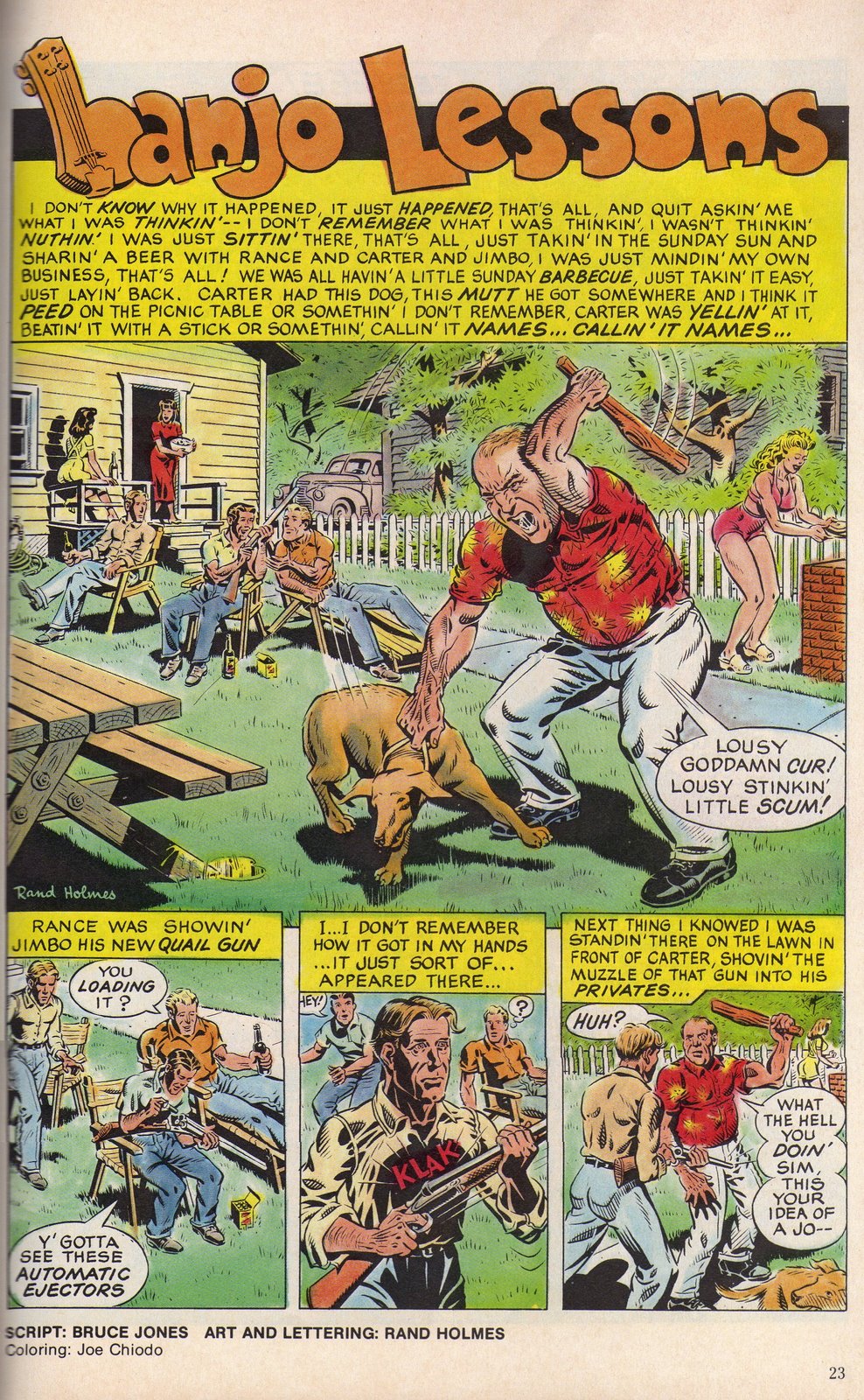 And that's tame, compared to later images. April Campbell wrote a pre-emptive argument in support of the intent of the story, which was bound to be controversial. The next issues letters featured some responses, some in support, others arguing that the sensationalism negated the social commentary. I'll be honest, this kind of stuff isn't really my cup of tea. I don't mind something like a Mike Ploog or Michael T Gilbert horror story, with a sense of humor; but, I'm not much for people taking axes to each other or blasting with shotguns. There is a mixture in these tales, though violence is quite high. There are more humorous stories, though. If you enjoy Warren or EC, you may also like this material.      Having said the above, I love this stuff from Berni Wrightson. Horror isn't my thing; but, you can't beat the mood and atmosphere that Wrightson brings to his work. The technique is stunning. These are reprints of some of his work at Warren, including the famous "Jenifer." 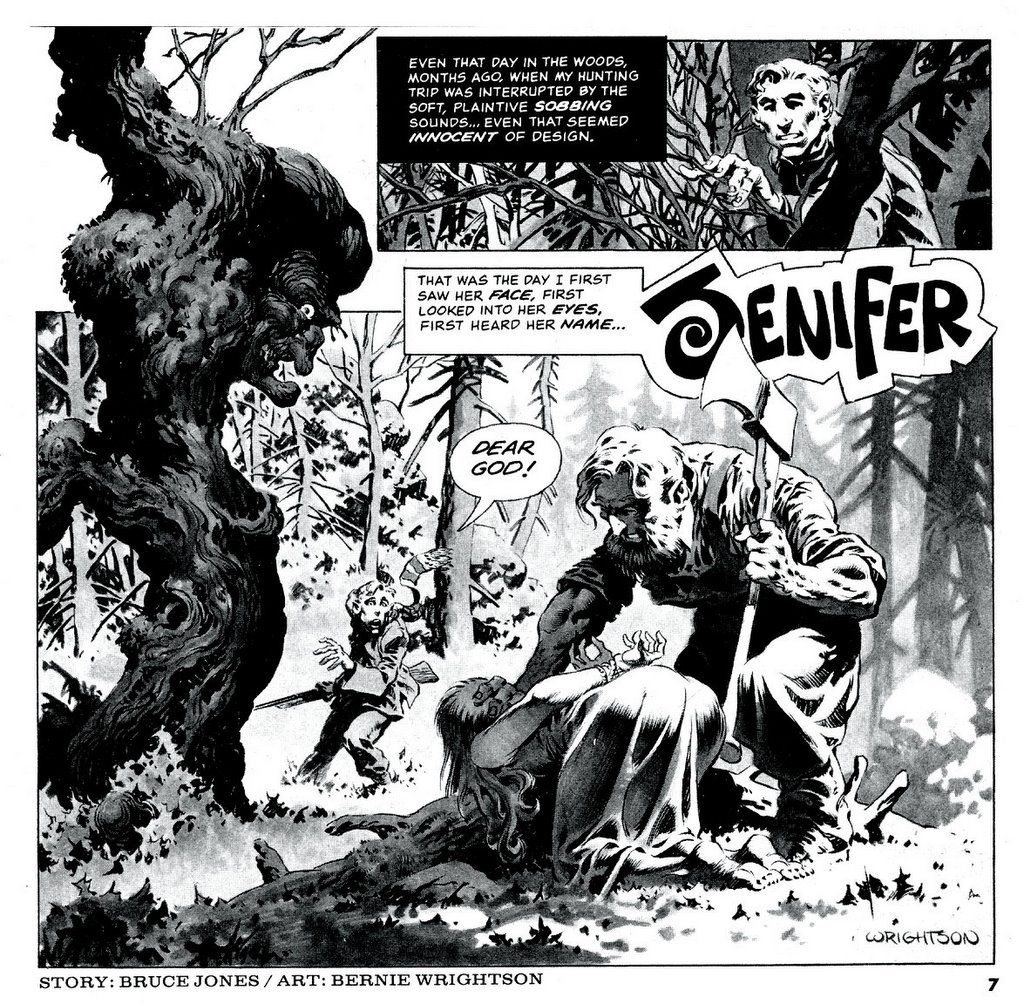        Vanguard Illustrated was a bit more up my alley. This tended more to the sci-fi side of things and was filled with great little tales, by mostly then-unknown or young talent. Issue one starts with a bang, with Tom Yeates channeling Virgil Finlay, on the cover.  This series featured the earliest work of Steve Rude (though Nexus was published first), in Encyclopedias, a tale of an Encyclopedia salesman, in a post-apocalyptic world. It's filled with baron's biting tone and Rude's dynamic art, though it is very rough, compared to Nexus and later.   The series also features "Freakwave", from Peter Milligan and Brendan McCarthy. 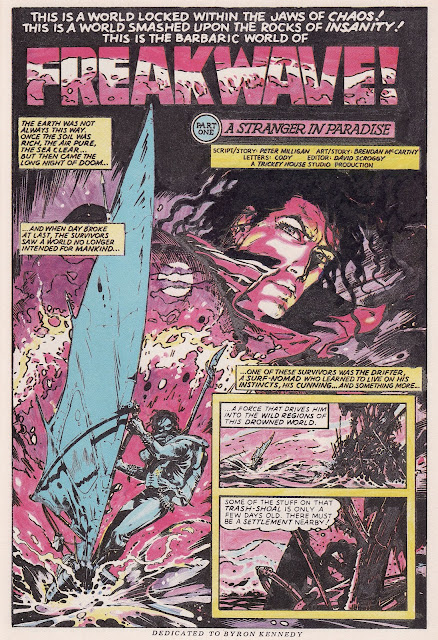 Think of it as Waterworld, only with a better story and more gonzo (and less Kevin Costner blandness). Dave Campiti and Cynthy J Wood bring us Legends of the Stargrazers, with a truly great Dave Stevens cover (issue #2). The series features the adventure of a group of female pirates and smugglers (like distaff Han Solos) 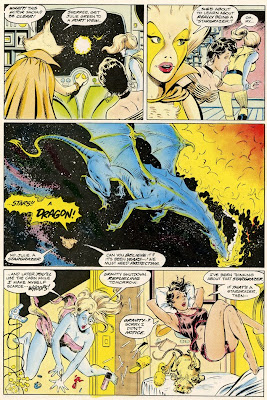 It's all very lighthearted and very T & A. The series would be picked up, a few years later, at Campiti's Innovation Comics, with contributions from people like Adam Hughes.    Yeah, it's not exactly Ms Magazine material. Campiti also offered us "Be It What It Will, I'll Go To It Laughing," and homage to Ray Bradbury (and Harlan Ellison and L Frank Baum) and the power of dreamers. The art from Tom Yeates is beautiful and the sentiment even moreso (issue 3). 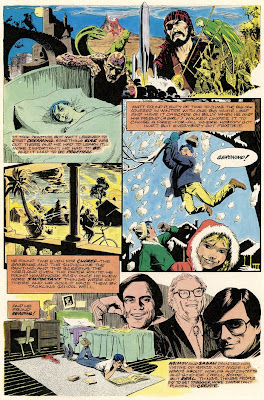 Rick Geary has a delightful tale, in issue 4, called "Student Filmmaker." It's a single page and tells more story than most 20 page ones of today. Bill Dubay and Vince Argondezzi give us "The Legend of Hump Hammersmith, Buttkicker At Large." More delightful fun. Joey Cavalieri and George Perez bring us the silent tale, "The Trains Belong to Us," about some graffiti artists, with a benefactor. it's a couple of pages, no dialogue; but, it' storytelling from a confident master. 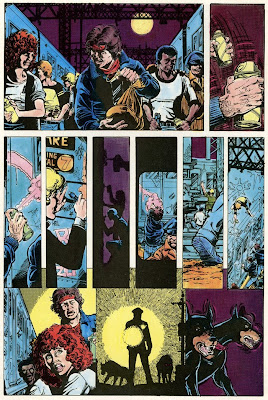 Finally, there is the debut of Mr Monster! Well, technically, it's the revival, as he was actually a Canadian comic book character that Michael T. Gilbert stumbled across. He revived him for some pulpy, yet humorous monster fighting. Here, in this first story, Gilbert is aided by the art of William Messner-Loebs. The story is "The Case of the Reluctant Werewolf." It features the story of humble Myron Clotz, a functionary at IBM, with poor taste in sports coats, who is bitten by a werewolf. he didn't ask for this and it is playing havoc with his efficiency ratings at IBM and adding expenses (razor blades, hair cuts, dental bills). Well, our nebbish werewolf is being pressured to join a gang of werewolf bikers and he caves. he is sent on his initiation and is about to attack a woman, who he recognizes as Millie Feinstein. Millie recognizes the sports coat and tells Myron she finds his aggression sexy. They become an item, which angers the bikers. The leader threatens to kill Millie unless Myron kills Doc Stearn, Mr Monster. Doc says he will help out, as he has been looking for the leader of the gang. Unfortunately, that was the end of the story and Pacific. Luckily, Eclipse picked up the story and the first issue, intended for Pacific, which picked up the tale. 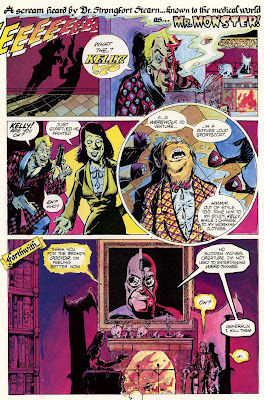 More on Mr Monster, in the future. So, that's pretty much it for Pacific, though it isn't everything they published. it is, however, all I have access to. It was a neat little company, while it lasted. Unfortunately, its distribution expenses outweighed its publishing revenue and they were sunk by debt. One of the key factors was that they were distributing competitors, like Renegade and Eclipse, and many of their comic shops defected and publishers stopped using them. They declared bankruptcy and Steve Schanes went off and started Blackthorne, leaving several creditors in the lurch, including unpaid creative talent. Needless to say, few of them turned up at Blackthorne. Bill Schanes went to work for Steve Geppi, at Diamond. Some of their titles, like Mr Monster, Alien Worlds, Twisted Tales and The Rocketeer ended up at Eclipse. Others never again saw the light of day. However, it was their independent spirit that helped fuel the boom of independent companies in the early and mid-80s, with companies like Eclipse, Aardvark-Vanaheim, Renegade, First, Fantagraphics, Comico and Dark Horse entering (and leaving) the field. it spurred Neal Adams into starting Continuity Comics, once and for all. The offered creative ownership and royalties, when the Big Two didn't, which led to changes there, including royalties and things like Epic. It also gave us some great little comics, for a brief, shining moment. |
|
|
|
Post by EdoBosnar on Jan 16, 2017 10:19:41 GMT -5
Yeah, that's a nice little summary of Pacific; as I said in a preceding comment somewhere up there, I have a sentimental fondness for the company because they launched not long after I discovered my first comic book shop, so I was in on the ground floor, so to speak.
Even so, I missed out on a lot of their stuff, most notably two of the titles you highlighted here: Alien Worlds and Vanguard Illustrated. I love good SF anthology comics, and it seems like there's so much good stuff in these.
Anyway, thanks again from me for showing a little love for Pacific.
|
|
Confessor
CCF Mod Squad
Not Bucky O'Hare!
Posts: 10,197  Member is Online
Member is Online
|
Post by Confessor on Jan 16, 2017 10:42:34 GMT -5
Love the Rocketeer. It's thin on story but huge on style, period detail and heroic daring do. Pretty, pretty pictures too.
Regarding how much Betty Page contributed to the success of the series, it's hard to tell, but I do think that the Rocketeer initiated the Cult of Betty Page revival of interest in her in the 1990s. Prior to the Rocketeer, she was an all but forgotten '50s cheesecake model, but Dave Stevens' use of her in the Rocketeer sparked a resurgence of interest in her among the nerdy comic set and from there the wider Generation X'er demographic.
Anyway, great write up as always, codystarbuck.
Until recently I had the full run of Vangard Illustrated, but I sold them last year. Fun series.
|
|
|
|
Post by berkley on Jan 16, 2017 14:56:26 GMT -5
Regarding how much Betty Page contributed to the success of the series, it's hard to tell, but I do think that the Rocketeer initiated the Cult of Betty Page revival of interest in her in the 1990s. Prior to the Rocketeer, she was an all but forgotten '50s cheesecake model, ... Not by Chris Spedding! |
|
Confessor
CCF Mod Squad
Not Bucky O'Hare!
Posts: 10,197  Member is Online
Member is Online
|
Post by Confessor on Jan 16, 2017 17:34:17 GMT -5
Regarding how much Betty Page contributed to the success of the series, it's hard to tell, but I do think that the Rocketeer initiated the Cult of Betty Page revival of interest in her in the 1990s. Prior to the Rocketeer, she was an all but forgotten '50s cheesecake model, ... Not by Chris Spedding! Well no, but as the b-side of a flop single that didn't even chart in the UK or U.S. that song hardly raised Betty Page's profile to any meaningful degree.  |
|
|
|
Post by codystarbuck on Jan 16, 2017 22:42:23 GMT -5
A few things raised Bettie's profile; all of which seemed to occur around the same time. The Rocketeer was one, the Betty Page, from Greg Theakston, was another, and some fetish and cheesecake books and magazines from Bellier press and Glamour International did a lot to bring attention to her. I remember seeing an issue of Steranko's Prevue magazine and he used to advertise art and photo books and graphic novels for sale from his Supergraphics company (I got his 1970s superhero women calendar, a signed British Captain America album, and some Modesty Blaise trades from him) and he had a ton of that stuff listed in there. An article in La Weekly led to the Lifestyles of the Rich and Famous segment, where Bettie spoke off camera. The movie brought a lot of attention. The art of Olivia De Berardinis was another, as well as the paintings of Robert Blue.
I do think it was one of the key elements that attracted people to the comic. The action and adventure, as well as the humor, were great draws; but, Betty added a ton of visual appeal to it, especially with the cheesecake poses. Every article I saw about the comic focused heavily on Betty and the same was true of publicity around the movie (except Disney, who barely marketed the thing, upon release).
|
|
|
|
Post by codystarbuck on Jan 16, 2017 23:49:55 GMT -5
I wanna dive into some more 80s independents; but, before I do, I wanted to highlight one of my favorite series from the 90s: 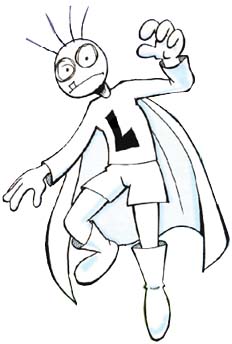 LETHARGIC LAD!!!!!!!!!!!!!     The character is the creation of Canadian cartoonist Greg Hyland, who first drew the character in high school. The character appeared in a series of mini-comics, before being published in a regular comic, in 1991, in Lethargic Comics Weekly. The character is secretly Larry Ladhands, a mild mannered (practically catatonic) millionaire playboy, who secretly fights crime at night as Lethargic Lad! If that sounds like a Batman rip-off it's because the character started out parodying the Tim Burton Batman movie, with a character who just stands there and says "Ummmmmmmmmmmmm................" Criminals flee in terror. His chief enemy is Evil Smiley Face Guy, who looks suspiciously like the Joker, except with a smiley face for a head. One of his other great enemies was Mr Mimico, who engaged Lethargic Lad in a staredown, where they both looked at each other and said "Ummmmmmmmmmmmmmmmm" It's hard to do the series justice via words; but, it was one of the funniest funnybooks out there. It was filled with gags poking fun at Batman, 90s comics (the book savaged the Image crowd), the Batman tv series, Superman, the Japanese Spider-Man series, and much, much more. We eventually learn that Larry Ladhands stumbled across Adam West, still dressed as Batman, at the Greenway studios (the production company of the tv series). West trains Larry to be a superhero, with a hilarious panel of Lethargic Lad in the Batman costume, with Mr West berating him, "No, no; you went down the wrong pole! Didn't you read the signs?" A later issue gives a schematic of a mechanical contrivance that explains how Bruce Wayne and Dick Grayson changed costume as the went down the Bat-poles. The Lethargic Comics Weakly iteration also featured other characters, including:  The Grad, a teenager killed at graduation, who resembled a certain freckle-faced Riverdale teen.  Him, another superhero, who fought the Rubber Skull and various other villains; he later joined the No-Mutants     a team of superheroes, with no powers, who included (from left to right) Chad. Food Eater Lad (Jeremy), Rhonda and Elvis Ed  Walrus Boy, secretly teen Peter Swartz, who was bitten by a radioactive walrus (which was dangling from the ceiling, in a science lab)  Guy-With-A-Gun, a gun-toting vigilante, who later met  Guy-With-A-Gun Girl. The series was then revamped and streamlined into Lethargic Comics, from Alpha Productions...        Then, it moved to Crusade    Destination...    and then Lethargic Comics    The material was later collected into the Big Book of Lethargic Lad  and the Lethargic Lad Do-It Yourself Trade Paperback. Hyland turned Lethargic Lad into a webcomic, in 2000, at www.lethargiclad.com/code.htm Since then, the character and supporting cast have been seen in weekly strips, which have been colelcted into books, sold via the site. Hyland also wrote The Tick, Mighty Blue Justice, in 1997 (at the height of the cartoon's popularity) and has created storyboards for Lego animation projects. Check out the revamped site here, to get a feel for the fun: www.lethargiclad.com/The series had a ton of pro fans, including Alex Ross (who collaborated on the Kingdom Come parody cover, on Crusade Comics Lethargic Lad #3) and Dave Sim (who did the Cerebus cover of Lethargic Comics #14, at Alpha Productions) and Bill Tucci, who published the book at his Crusade Comics, for a brief time. Do yourself a favor, if you like absurd humor, snarky swipes at other comics, pop culture references or just plain goofy fun, you will like Lethargic Lad. |
|